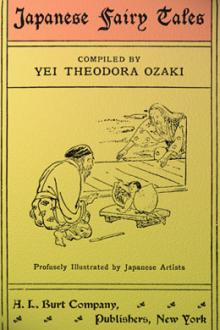Indian Fairy Tales Joseph Jacobs (books to read to improve english .txt) 📖

- Author: Joseph Jacobs
Book online «Indian Fairy Tales Joseph Jacobs (books to read to improve english .txt) 📖». Author Joseph Jacobs
Source.—Miss Stokes, Indian Fairy Tales, pp. 73–84. Majnun and Laili are conventional names for lovers, the Romeo and Juliet of Hindostan.
Parallels.—Living in animals’ bellies occurs elsewhere in Miss Stokes’ book, pp. 66, 124; also in Miss Frere’s, 188. The restoration of beauty by fire occurs as a frequent theme (Temple, Analysis, III vi f. p. 418). Readers will be reminded of the dénouement of Mr. Rider Haggard’s She. Resuscitation from ashes has been used very effectively by Mr. Lang in his delightful Prince Prigio.
Remarks.—The white skin and blue eyes of Prince Majnun deserve attention. They are possibly a relic of the days of Aryan conquest, when the fair-skinned, fair-haired Aryan conquered the swarthier aboriginals. The name for caste in Sanskrit is varna, “colour”; and one Hindu cannot insult another more effectually than by calling him a black man. Cf. Stokes, pp. 238–9, who suggests that the red hair is something solar, and derived from myths of the solar hero.
IX The Tiger, the Brahman, and the JackalSource.—Steel-Temple, Wideawake Stories, pp. 116–20; first published in Indian Antiquary, XII p. 170 seq.
Parallels.—No less than 94 parallels are given by Prof. K. Krohn in his elaborate discussion of this fable in his dissertation, Mann und Fuchs, (Helsingfors, 1891), pp. 38–60; to which may be added three Indian variants, omitted by him, but mentioned by Capt. Temple, l. c., p. 324, in the Bhâgavata Purâna, the Gul Bakâolî and Indian Antiquary XII 177; and a couple more in my Aesop, p. 253: add Smeaton, Karens, p. 126.
Remarks.—Prof. Krohn comes to the conclusion that the majority of the oral forms of the tale come from literary versions (p. 47), whereas the Reynard form has only had influence on a single variant. He reduces the century of variants to three type forms. The first occurs in two Egyptian versions collected in the present day, as well as in Petrus Alphonsi in the twelfth century, and the Fabulae Extravagantes of the thirteenth or fourteenth: here the ingrate animal is a crocodile, which asks to be carried away from a river about to dry up, and there is only one judge. The second is that current in India and represented by the story in the present collection: here the judges are three. The third is that current among Western Europeans, which has spread to S. Africa and N. and S. America: also three judges. Prof. K. Krohn counts the first the original form, owing to the single judge and the naturalness of the opening, by which the critical situation is brought about. The further question arises, whether this form, though found in Egypt now, is indigenous there, and if so, how it got to the East. Prof. Krohn grants the possibility of the Egyptian form having been invented in India and carried to Egypt, and he allows that the European forms have been influenced by the Indian. The “Egyptian” form is found in Burma (Smeaton, l. c., p. 128), as well as the Indian, a fact of which Prof. K. Krohn was unaware though it turns his whole argument. The evidence we have of other folktales of the beast-epic emanating from India improves the chances of this also coming from that source. One thing at least is certain: all these hundred variants come ultimately from one source. The incident “Inside again” of the Arabian Nights (the Djinn and the bottle) and European tales is also a secondary derivate.
X The Soothsayer’s SonSource.—Mrs. Kingscote, Tales of the Sun (p. 11 seq.), from Pandit Natesa Sastri’s Folklore of Southern India, pt. II, originally from Indian Antiquary. I have considerably condensed and modified the somewhat Babu English of the original.
Parallels.—See Benfey, Pantschatantra, § 71, I pp. 193–222, who quotes the “Karma Jātaka” as the ultimate source: it also occurs in the “Saccankira Jātaka” (Fausböll, No. 73), trans. Rev. R. Morris, Folklore Jour. III 348 seq. The story of the ingratitude of man compared with the gratitude of beasts came early to the West, where it occurs in the Gesta Romanorum, c. 119. It was possibly from an early form of this collection that Richard Cœur de Lion got the story, and used it to rebuke the ingratitude of the English nobles on his return in 1195. Matthew Paris tells the story, sub anno (it is an addition of his to Ralph Disset), Hist. Major, ed. Luard, II 413–6, how a lion and a serpent and a Venetian named Vitalis were saved from a pit by a woodman, Vitalis promising him half his fortune, fifty talents. The lion brings his benefactor a leveret, the serpent “gemmam pretiosam,” probably “the precious jewel in his head” to which Shakespeare alludes (As You Like It, ii I, cf. Benfey, l. c., p. 214, n.), but Vitalis refuses to have anything to do with him, and altogether repudiates the fifty talents. “Haec referebat Rex Richardus munificus, ingratos redarguendo.”
Remarks.—Apart from the interest of its wide travels, and its appearance in the standard medieval History of England by Matthew Paris, the modern story shows the remarkable persistence of folktales in the popular mind. Here we have collected from the Hindu peasant of today a tale which was probably told before Buddha, over two thousand years ago, and certainly included among the Jatakas before the Christian era. The same thing has occurred with “The Tiger, Brahman, and Jackal” (No. IX supra).
XI HarisarmanSource.—Somadeva,





Comments (0)